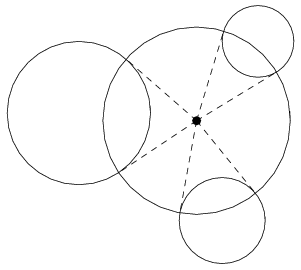Orthogonal Circles

( x − 1 5 3 ) 2 + y 2 ( x + 1 5 3 ) 2 + y 2 x 2 + ( y − 1 3 8 0 ) 2 = = = 1 8 5 2 1 8 5 2 1 9 6 2
Above shows the equations for 3 circles.
Two circles are orthogonal to each other if where they intersect meets at right angles. The circle that is orthogonal to all three of the circles above can be written as:
x 2 + ( y − k ) 2 = r 2 .
Find k + r .
The answer is 1352.
This section requires Javascript.
You are seeing this because something didn't load right. We suggest you, (a) try
refreshing the page, (b) enabling javascript if it is disabled on your browser and,
finally, (c)
loading the
non-javascript version of this page
. We're sorry about the hassle.
1 solution
Moderator note:
What is special about this center?
Hint: Power of a point.
I believe you meant that r = 6 7 2 , not r = 6 2 7 . Great solution though!
Two circles x 2 + y 2 + 2 g x + 2 f y + c = 0 and x 2 + y 2 + 2 g ′ x + 2 f ′ y + c ′ = 0 are orthogonal if 2 g g ′ + 2 f f ′ = c + c ′ (see Orthogonal Circles ).
Now we have:
⎩ ⎪ ⎪ ⎪ ⎨ ⎪ ⎪ ⎪ ⎧ ( x − 1 5 3 ) 2 + y 2 = 1 8 5 2 ( x + 1 5 3 ) 2 + y 2 = 1 8 5 2 x 2 + ( y − 1 3 8 0 ) 2 = 1 9 6 2 x 2 + ( y − k ) 2 = r 2 ⇒ x 2 + y 2 − 3 0 6 x − 1 0 8 1 6 = 0 ⇒ x 2 + y 2 + 3 0 6 x − 1 0 8 1 6 = 0 ⇒ x 2 + y 2 − 2 7 6 0 y + 1 8 6 5 9 8 4 = 0 ⇒ x 2 + y 2 − 2 k y + k 2 − r 2 = 0 . . . ( 1 ) . . . ( 2 ) . . . ( 3 ) . . . ( 4 )
Considering 2 g g ′ + 2 f f ′ = c + c ′ , we have
⎩ ⎪ ⎨ ⎪ ⎧ ( 1 ) & ( 4 ) : ( 3 ) & ( 4 ) : ( 5 ) : 0 = k 2 − r 2 − 1 0 8 1 6 ⇒ k 2 − r 2 = 1 0 8 1 6 . . . ( 5 ) 2 7 6 0 k = k 2 − r 2 + 1 8 6 5 9 8 4 = 1 0 8 1 6 + 1 8 6 5 9 8 4 ⇒ k = 6 8 0 k 2 − r 2 = 1 0 8 1 6 ⇒ r 2 = 6 8 0 2 − 1 0 8 1 6 ⇒ r = 6 7 2
⇒ k + r = 6 8 0 + 6 7 2 = 1 3 5 2